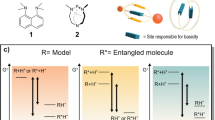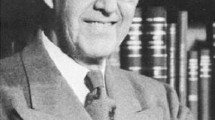Abstract
First reported by Joseph Bunnet et al., base-catalyzed halogen dance reaction has puzzled chemists for decades, to come up with new ideas regarding the mechanism of this chemical reaction. A series of deprotonation followed by fast metal-halogen exchanges are among the most recent mechanisms reported so far. Using density functional theory, DFT, computations and focused on the Bunnet type isomerization halogen dance reactions of iodobenzene derivatives, iodo-bridged transition state, TS, are proposed. The new TS is then used to lay out 8 possible isomerization and 18 possible disproportionation paths. The possible mechanistic pathways are then carefully analyzed based on TS’s energy and protonation/deprotonation steps to find the most suitable pathways. These mechanistic pathways, sketch a comprehensive pattern for base-catalyzed halogen dance. There is still a lot to study in the chemistry of poly halogenated aryls.








Similar content being viewed by others
References
Mubarak MS, Peters DG (1996) Electrochemical reduction of mono-and dihalothiophenes at carbon cathodes in dimethylformamide. First example of an electrolytically induced halogen dance. J Org Chem 61(23):8074–8078
Suschitzky H, Scriven EFV (2013) Critical Review of the 1993 Literature Preceded by Two Chapters on Current Heterocyclic Topics. In: Progress in heterocyclic chemistry Elsevier, p 350. https://books.google.com/books?id=5CL9BAAAQBAJ&dq=Substituted+heterocyclic+compounds+by+selective+control+of+halogen-dance+reactions.+Progress+in+Heterocyclic+Chemistry&lr=&source=gbs_navlinks_s
Bailey WF, Patricia JJ (1988) The mechanism of the lithium–halogen interchange reaction: a review of the literature. J Organomet Chem 352(1–2):1–46
Bunnett JF (1972) Base-catalyzed halogen dance, and other reactions of aryl halides. Acc Chem Res 5(4):139–147
Duan X-F, Zhang Z-B (2005) Recent progress of halogen-dance reactions in heterocycles. Heterocycles 65(8):2005–2012
Schlosser M (2005) The 2 × 3 toolbox of organometallic methods for regiochemically exhaustive functionalization. Angew Chem Int Ed 44(3):376–393
Jones L, Whitaker BJ (2016) Modeling a halogen dance reaction mechanism: a density functional theory study. J Comput Chem 37(18):1697–1703
Vaitiekunas A, Nord F (1951) Tetrabromothiophene from 2-bromothiophene by means of sodium acetylide in liquid ammonia. Nature 168(4281):875
Vaitiekunas A, Nord F (1953) Studies on the chemistry of heterocyclics. XXII. Investigations on the mechanism of reactions of 2-thienyl halides with sodium amide and sodium acetylide in liquid ammonia. J Am Chem Soc 75(7):1764–1768
Stangeland EL, Sammakia T (2004) Use of thiazoles in the halogen dance reaction: application to the total synthesis of WS75624 B. J Org Chem 69(7):2381–2385
Sammakia T, Stangeland EL, Whitcomb MC (2002) Total synthesis of caerulomycin C via the halogen dance reaction. Org Lett 4(14):2385–2388
Fröhlich J, Hametner C, Kalt W (1996) Synthesis of trisubstituted thiophenesvia a halogen dance reaction at 2-bromo-5-methylthiophene. Monatsh Chem 127(3):325–330
Getmanenko YA, Tongwa P, Timofeeva TV, Marder SR (2010) Base-catalyzed halogen dance reaction and oxidative coupling sequence as a convenient method for the preparation of dihalo-bisheteroarenes. Org Lett 12(9):2136–2139
Stanetty P, Schnürch M, Mereiter K, Mihovilovic MD (2005) Investigations of the halogen dance reaction on N-substituted 2-thiazolamines. J Org Chem 70(2):567–574
Nora V, de Souza M (2007) Halogen dance reaction and its application in organic synthesis. Curr Org Chem 11(7):637–646
Schnürch M (2011) Recent progress on the halogen dance reaction on heterocycles. In: Jernej I (ed) Halogenated heterocycles. Springer, pp 185–218. https://link.springer.com/book/10.1007/978-3-642-25103-0
Miller RE, Rantanen T, Ogilvie KA, Groth U, Snieckus V (2010) Combined directed ortho metalation—halogen dance (HD) synthetic strategies. HD—anionic ortho fries rearrangement and double HD sequences. Org Lett 12(10):2198–2201
Gakh AA, Tuinman AA (2001) ‘Fluorine dance’ on the fullerene surface. Tetrahedron Lett 42(41):7137–7139
Donham LL, Gronert S (2019) Substitution reactions on iodine and bromine-mechanisms for facile halogenations of heterocycles. J Org Chem 84(9):5757–5762. https://doi.org/10.1021/acs.joc.9b00721
Schnürch M, Spina M, Khan AF, Mihovilovic MD, Stanetty P (2007) Halogen dance reactions—a review. Chem Soc Rev 36(7):1046–1057
Uzelac EJ, Rasmussen SC (2017) Synthesis of brominated thiazoles via sequential bromination-debromination methods. J Org Chem 82(11):5947–5951
Shi Q, Zhang S, Zhang J, Oswald VF, Amassian A, Marder SR, Blakey SB (2016) KO t Bu-initiated aryl C–H iodination: a powerful tool for the synthesis of high electron affinity compounds. J Am Chem Soc 138(12):3946–3949
Hebade MJ, Kamble RD, Hese SV, Mogle PP, Ambhore AN, Kadam SN, Dawane BS (2016) A rapid, mild, and efficient method for C-5 iodination/thiocyanation of 2-aminothiazoles. Phosphorus Sulfur Silicon Relat Elm 191(8):1155–1159
Liu X, Zhao X, Liang F, Ren B (2018) t-BuONa-mediated direct C–H halogenation of electron-deficient (hetero) arenes. Org Biomol Chem 16(6):886–890
Gronert S, Garver JM, Nichols CM, Worker BB, Bierbaum VM (2014) Dehalogenation of arenes via SN2 reactions at bromine: competition with nucleophilic aromatic substitution. J Org Chem 79(22):11020–11028
Soukup LL, Gronert S (2015) The gas-phase reactions of localized and delocalized carbanions with aryl halides: Competition between attack on the π-system and the periphery. Int J Mass Spectrom 378:31–37
Wang D, Lü R, Yuan M, Fu A, Chu T (2014) A DFT/TD-DFT study of thiazolidinedione derivative in dimethylformamide: cooperative roles of hydrogen bondings, electronic and vibrational spectra. Spectrochim Acta A Mol Biomol Spectrosc 125:131–137
Bouzzine S, Salgado-Morán G, Hamidi M, Bouachrine M, Pacheco AG, Glossman-Mitnik D (2015) DFT study of polythiophene energy band gap and substitution effects. J Chem 2015:1–12. https://www.hindawi.com/journals/jchem/2015/296386/
Torii H, Yoshida M (2010) Properties of halogen atoms for representing intermolecular electrostatic interactions related to halogen bonding and their substituent effects. J Comput Chem 31(1):107–116
Frisch M, Trucks G, Schlegel HB, Scuseria GE, Robb MA, Cheeseman JR, Scalmani G, Barone V, Mennucci B, Petersson G (2009) Gaussian 09, revision a. 02, Gaussian. Inc, Wallingford, p 200
Frisch M, Trucks G, Schlegel H, Scuseria G, Robb M, Cheeseman J, Zakrzewski V, Montgomery J Jr, Stratmann R, Burant J (2010) Gaussian 09, Revision A11. 4, Gaussian. Inc, Pittsburgh
Lu YX, Zou JW, Fan JC, Zhao WN, Jiang YJ, Yu QS (2009) Ab initio calculations on halogen-bonded complexes and comparison with density functional methods. J Comput Chem 30(5):725–732
Carrera EI, Seferos DS (2015) Efficient halogen photoelimination from dibromo, dichloro and difluoro tellurophenes. Dalton Trans 44(5):2092–2096
Lu Y, Zou J, Wang H, Yu Q, Zhang H, Jiang Y (2005) Triangular halogen trimmers. A DFT study of the structure, cooperativity, and vibrational properties. J Phys Chem A 109(51):11956–11961
Siiskonen A, Priimagi A (2017) Benchmarking DFT methods with small basis sets for the calculation of halogen-bond strengths. J Mol Model 23(2):50
Forni A, Pieraccini S, Rendine S, Gabas F, Sironi M (2012) Halogen-bonding interactions with π systems: CCSD (T), MP2, and DFT calculations. ChemPhysChem 13(18):4224–4234
Kolar MH, Hobza P (2016) Computer modeling of halogen bonds and other σ-hole interactions. Chem Rev 116(9):5155–5187
Mitin AV, van Wüllen C (2006) Two-component relativistic density-functional calculations of the dimers of the halogens from bromine through element 117 using effective core potential and all-electron methods. J Chem Phys 124(6):064305
Sedlak R, Riley KE, Řezáč J, Pitoňák M, Hobza P (2013) MP2. 5 and MP2. X: approaching CCSD (T) quality description of noncovalent interaction at the cost of a single CCSD iteration. ChemPhysChem 14(4):698–707
Kato M, Hada M, Fukuda R, Nakatsuji H (2005) Relativistic configuration interaction and coupled cluster methods using four-component spinors: magnetic shielding constants of HX and CH3X (X = F, Cl, Br, I). Chem Phys Lett 408(1–3):150–156
Liakos DG, Hansen A, Neese F (2010) Weak molecular interactions studied with parallel implementations of the local pair natural orbital coupled pair and coupled cluster methods. J Chem Theory Comput 7(1):76–87
Pearson RG (1986) Absolute electronegativity and hardness correlated with molecular orbital theory. PNAS 83(22):8440–8441
Duxbury DF (1993) The photochemistry and photophysics of triphenylmethane dyes in solid and liquid media. Chem Rev 93(1):381–433
Author information
Authors and Affiliations
Corresponding author
Electronic supplementary material
Below is the link to the electronic supplementary material.
Rights and permissions
About this article
Cite this article
Sakhaee, N., Sakhaee, S., Doustkhah, E. et al. Iodo-Bridged Transition States; New Mechanistic Pathways for Base-Catalyzed Halogen Dance. Chemistry Africa 4, 37–49 (2021). https://doi.org/10.1007/s42250-020-00197-6
Received:
Accepted:
Published:
Issue Date:
DOI: https://doi.org/10.1007/s42250-020-00197-6




